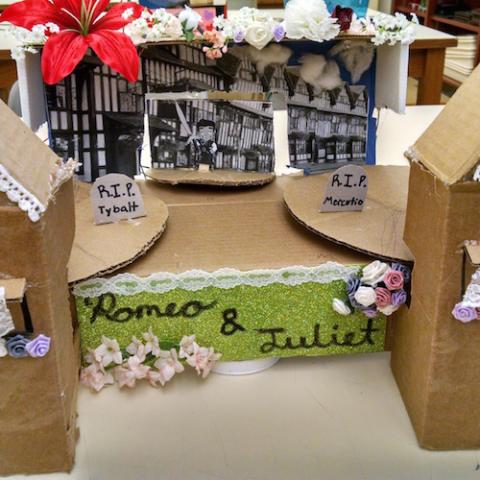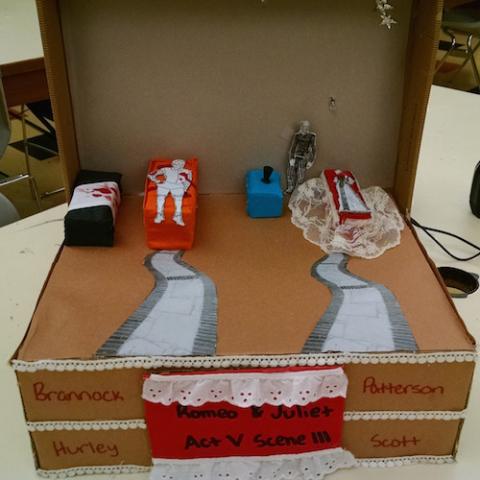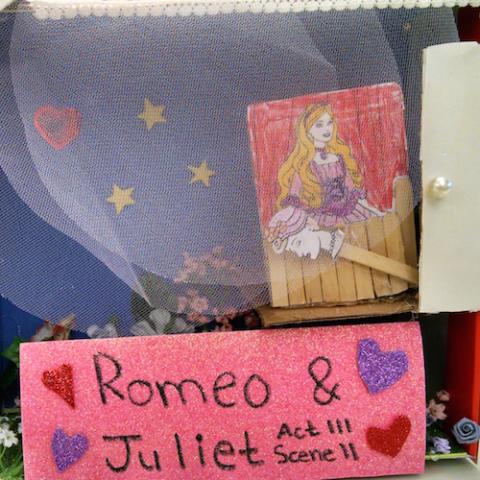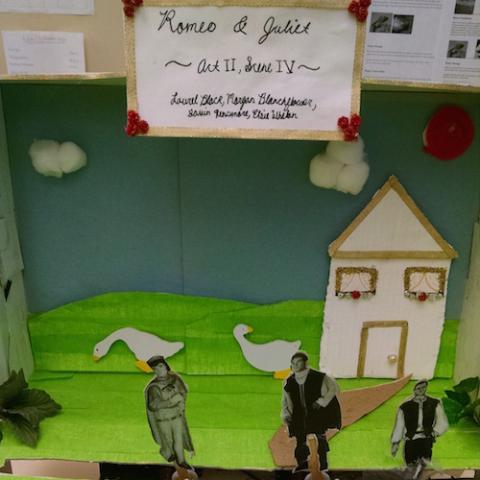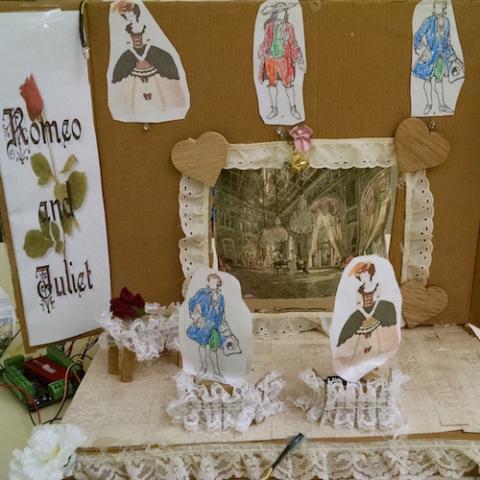Robot Shakespeare
Subjects
Language Arts, Art & Music
Project Type
Moving Scenes
Required Tutorials
Position servo, Rotation servo, Single color LED, & Tri-color LED
Estimated Time
Medium (3-6 hours)
Description
Create a robot diorama based on a passage from Shakespeare.
Free Teacher Materials
Teacher Credit
Heather Harapko, Dayna Hrin and Sue Mellon of Springdale Junior/Senior High in Pennsylvania
Project Map
Learning Goals
- Students will analyze a selection from Romeo and Juliet and decide how to use art and symbolism to express their understanding of this passage.
- Students will work in a group to design, build, and program a robotic diorama that represents their assigned selection.
- Students will defend their design decisions based on their analysis of the text.
Materials
- Hummingbird Bit Premium Kit
- Possible Craft supplies
Tips
- Have students work in groups of 2-3.
- Our Printables page has a variety of documents for making teaching and learning with Hummingbird easier. Visit and explore resources like the My First Robot Design Notebook now.
Steps
Students encountering Shakespeare for the first time need to read critical play passages many times to really understand them, but students may be reluctant to spend a significant period of time concentrating on a single passage. Making a robotic diorama can motivate students to analyze a passage more completely. At Springdale Junior/Senior High, English teachers Heather Harapko and Dayna Hrin worked with Gifted Support Coordinator Sue Mellon to enable all 80 eighth grade students to create robotic dioramas representing excerpts from Romeo and Juliet. Each group used art and robotic elements to show symbolically the important points of the passage; students also recorded audio files of their assigned passages. Many of these students had previous experience using the Hummingbird kit, which enabled them to build and program more complex dioramas within the eight 45-minute class sessions devoted to this project.
LESSON PROCEDURES:
This project was designed for students who already had experience using the Hummingbird robotics kit. If this is not the case for your students, you will need to add some basic instruction about how to use the Hummingbird components.
- Prior to beginning this project, choose a number of selections from Romeo and Juliet (or another play by Shakespeare). Choose passages that you want students to analyze thoroughly.
- Explain the project to students. Each group will analyze a passage from Romeo and Juliet and construct a robotic diorama to depict this passage. Provide a copy of the grading rubric to students.
- The robotic diorama should include a recording of the assigned passage.
- The diorama should use symbolism and art to represent important aspects of the assigned passage.
- Each diorama should contain at least four lights and at least 3 servos and/or motors.
- Each group must demonstrate their model to the class and defend their artistic decisions based on the text.
- Divide students into groups of 3 or 4. Assign each group a selection from Romeo and Juliet.
- Each group should complete the planning document (RobotShakespearePlanningDocument.pdf). This document requires students to analyze each portion of the text and describe how they will represent it in the robotic diorama.
- Based on their analysis of the text, students should plan their robotic diorama. The planning document includes space for students to think about their goals, identify their constraints, and develop their design.
- As students begin to build and program their diorama, they will need to record an audio file for the assigned passage. You can use either Snap! or BirdBlox to record and play back sound.
- Give students several class periods to build and program their dioramas. To complete the project within the time constraints, students must divide the work. For example, in a group of three, one student might work on building, one on programming, and one on recording the audio file for the assigned passage. The planning document provides space for students to decide who is responsible for each part of the project.
- On the last day or two of the project, have each group present their work to the class.
ASSESSMENT:
This project is assessed using the attached rubric (RobotTheaterRubric.pdf). This rubric incorporates items focusing on the robotic aspects of the project, as well as items assessing the group’s understanding of their selection from the play.
Check out some students talking about their work!
Standards Alignment
This project was designed to meet a number of Pennsylvania state standards in English Language Arts. These are listed below; in parentheses are the corresponding Common Core standards for English Language Arts. This project also incorporates Common Core ELA standards in speaking (SL.7.1, SL.7.4, and SL.7.5).
Reading Literature (Grades 7 and 8)
CC.1.3.7.B (CCSS.ELA-LITERACY.RL.7.1, Anchor Standard CCRA.R.1)
Cite several pieces of textual evidence to support analysis of what the text says explicitly, as well as inferences, conclusions, and/or generalizations drawn from the text.
CC.1.3.7.C (CCSS.ELA-LITERACY.RL.7.3, Anchor Standard CCRA.R.3)
Analyze how particular elements of a story or drama interact and how setting shapes the characters or plot.
CC.1.3.7.F (CCSS.ELA-LITERACY.RL.7.4, Anchor Standard CCRA.R.4)
Determine the meaning of words and phrases as they are used in grade-level reading and content, including interpretation of figurative, connotative meanings.
CC.1.3.8.B (CCSS.ELA-LITERACY.RL.8.1, Anchor Standard CCRA.R.1)
Cite the textual evidence that most strongly supports an analysis of what the text says explicitly, as well as inferences, conclusions, and/or generalizations drawn from the text.
CC.1.3.8.C (CCSS.ELA-LITERACY.RL.8.3, Anchor Standard CCRA.R.3)
Analyze how particular lines of dialogue or incidents in a story or drama propel the action, reveal aspects of a character, or provoke a decision.
CC.1.3.8.F (CCSS.ELA-LITERACY.RL.8.4, Anchor Standard CCRA.R.4)
Analyze the influence of the words and phrases in a text including figurative and connotative meanings and how they shape meaning and tone.
This project also meets three Pennsylvania standards for Technology and Engineering Design. These are listed below. They are analogous to the middle school engineering standards in the Next Generation Science Standards (MS-ETS1-1, MS-ETS1-2, MS-ETS1-3, and MS-ETS1-4).
3.4.8.C1. Evaluate the criteria and constraints of a design.
3.4.8.C2. Explore the design process as a collaborative endeavor in which each person in the group presents his or her ideas in an open forum.
3.4.8.C3. Analyze how a multidisciplinary (STEM) approach to problem solving will yield greater results.

